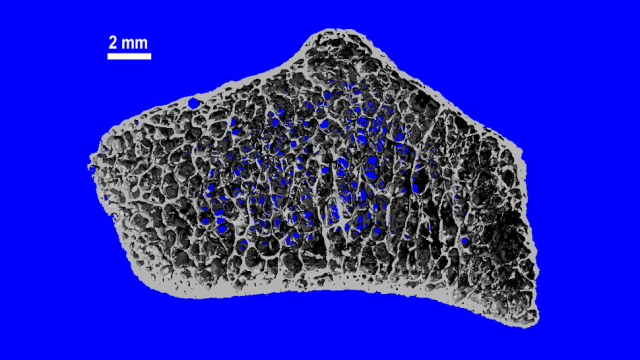Long-term exposure to microgravity results in the loss of bone density, and new research reveals the disturbing extent to which this happens and finds that astronauts may never fully recover.
“The detrimental effect of spaceflight on skeletal tissue can be profound,” reads the opening sentence of new research published today in Scientific Reports. Profound is right. The study, led by kinesiologists Leigh Gabel and Steven Boyd from the University of Calgary, found that astronauts who participate in long-duration spaceflights (i.e. missions longer than three months) exhibit signs of incomplete bone recovery even after a full year back on Earth. Long-duration missions, it would seem, result in the premature ageing of the bones, particularly bones in the weight-bearing lower extremities.
“We found that weight-bearing bones only partially recovered in most astronauts one year after spaceflight,” Gabel said in a statement. “This suggests the permanent bone loss due to spaceflight is about the same as a decade worth of age-related bone loss on Earth.”
The good news, if there is any in all of this, is that space-based resistance training can serve to limit the amount of bone loss and speed recovery. Previous research by the same team showed that “astronauts were more likely to preserve their bone density and strength if they increased in-flight lower body resistance training volume relative to preflight,” as the scientists write.
The new research shows how dependent we are on gravity for maintaining our bone strength. Each day is a constant struggle against gravity, but all this work does our body good, as it continually strengthens our bones. In space, however, astronauts just float around with barely any physical resistance, resulting in the gradual loss of bone density.
“Bone loss happens in humans — as we age, get injured, or any scenario where we can’t move the body, we lose bone,” Gabel said. “Understanding what happens to astronauts and how they recover is incredibly rare. It lets us look at the processes happening in the body in such a short time frame.”
The team travelled to NASA’s Johnson Space Centre in Houston, Texas, to perform the study. In total, 17 international astronauts (14 men and three women) were studied, all of whom performed long-duration missions at some point during the past seven years. The astronauts were evaluated prior to their ISS spaceflights, and then six and 12 months after their return to Earth.
The team took bone scans of specific anatomical areas, namely the tibia, or shinbone, and the forearm. This allowed the scientists to measure the susceptibility of these bones to fracturing (or “failure load,” in the vernacular of kinesiologists), and the amount of bone mineral content and the thickness of bone tissue. They also recorded the astronauts’ workout routines during and after their space missions, including exercises such as deadlifts, running on a treadmill, and cycling.
Of the 17 astronauts studied, 16 exhibited incomplete recoveries of their shinbones (measures of their forearms didn’t really differ a year after the spaceflights). On average, the astronauts exhibited a tibia failure load capacity of 10,579 newtons prior to their spaceflights, but that dropped to 10,084 newtons upon their immediate return to Earth, for a loss of 495 newtons. The astronauts did manage to make a partial recovery in the year following their return, but they were still 152 newtons below their preflight tibia failure load values.
Their bone densities also took a beating. The astronauts had bone densities averaging 326 milligrams per cubic centimeter prior to their time in space, but this dropped to 282.5 mg per cubic centimeter upon their return — a drop of 43.5 mg per cubic centimeter.
“Our findings indicate that microgravity induces irreversible damage to bone strength, density, and trabecular bone microarchitecture,” the scientists wrote in their study. The trabecular bone is a “highly porous form of bone tissue that is organised into a network of interconnected rods and plates,” the function of which is to provide strength and channel external loads away from joints, according to unrelated research.
Unsurprisingly, the bone measures worsened depending on the length of the mission. The eight astronauts who were on the ISS for longer than six months recovered significantly less than those who participated in shorter missions, according to the study. At the same time, the astronauts who recovered the most tibia bone mineral density performed the most in-flight deadlift exercises.
“Since cramped quarters will be a limiting factor on future exploration-class missions, exercise equipment will need to be optimised for a smaller footprint,” the scientists write. “Resistance exercise training (particularly deadlifts and other lower-body exercises) will remain a mainstay for mitigating bone loss; however, adding a jumping exercise to on-orbit regimens may further prevent bone loss and reduce daily exercise time.”
These are important findings, particularly as NASA, through its upcoming Artemis program, is wanting to build a sustainable and prolonged presence on and around the Moon. The new research also speaks to future crewed missions to Mars, which will likewise feature prolonged stays in space. In addition to muscle atrophy and the loss of bone strength, microgravity imposes detrimental affects on the heart, eyes, brain, spine, cells, and overall physical fitness. It’s vital that we learn about all the risks associated with spaceflight and the best ways to mitigate them.
More: Missions to Mars Shouldn’t Exceed Four Years Due to Radiation Risks, Scientists Say.
